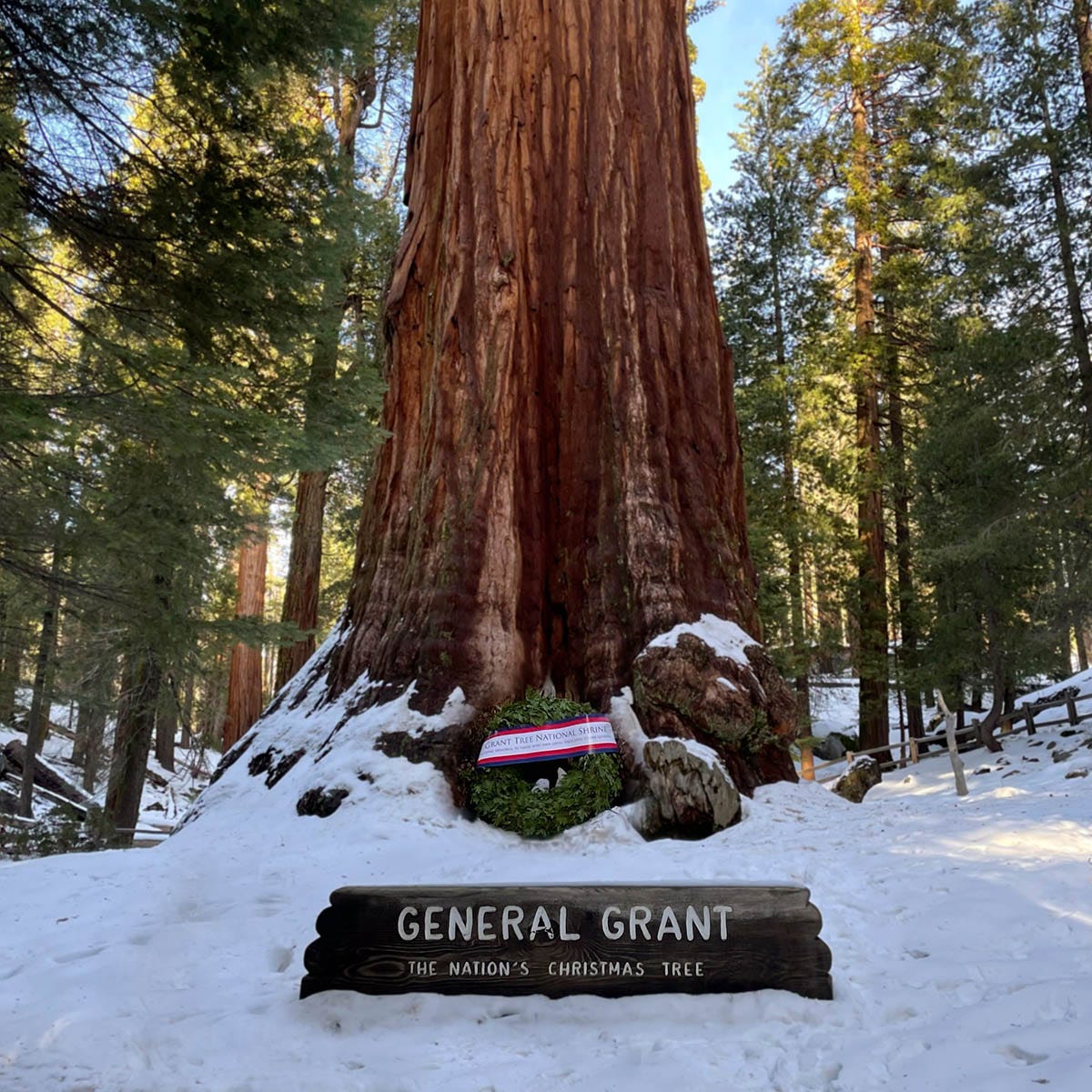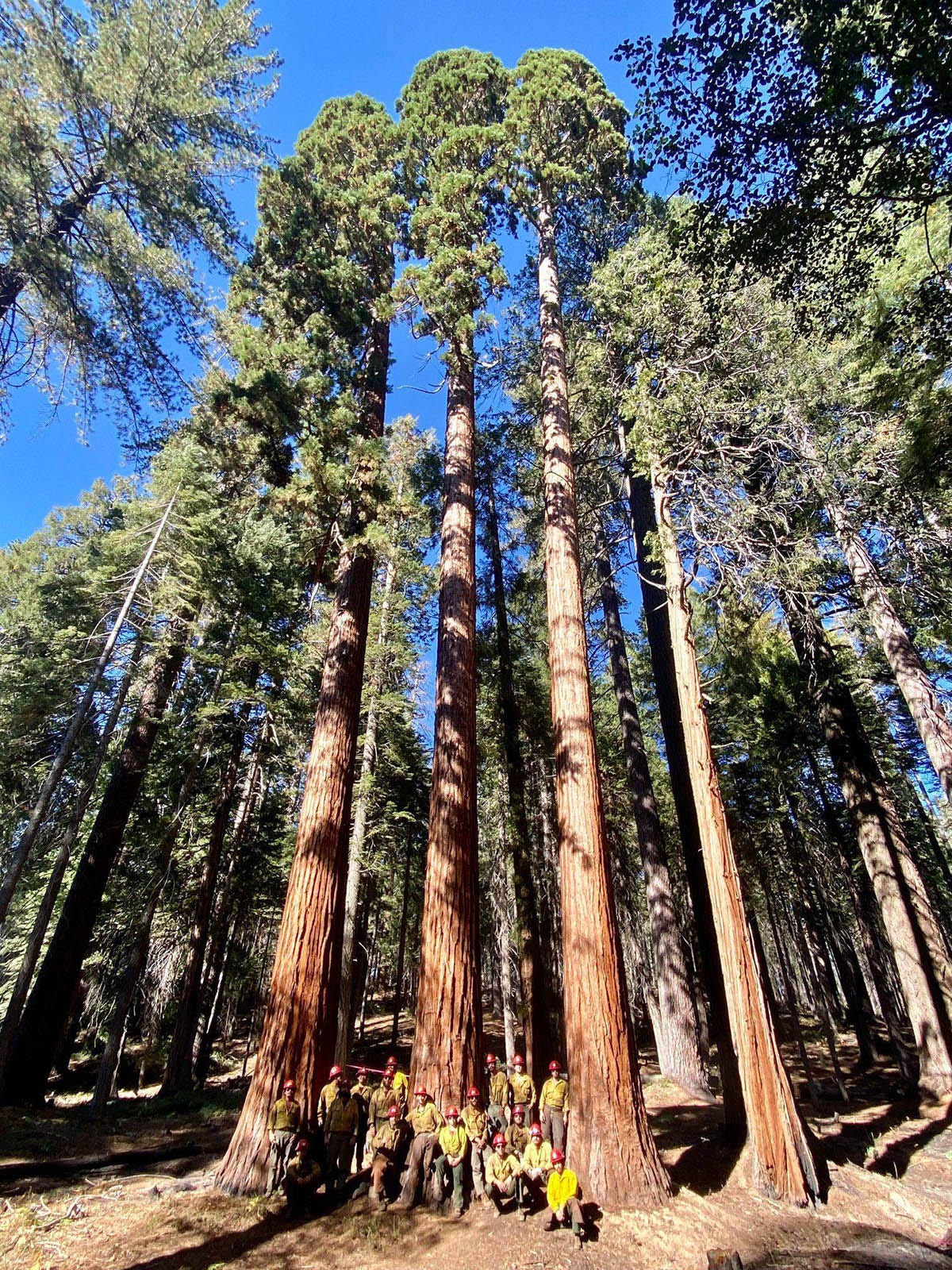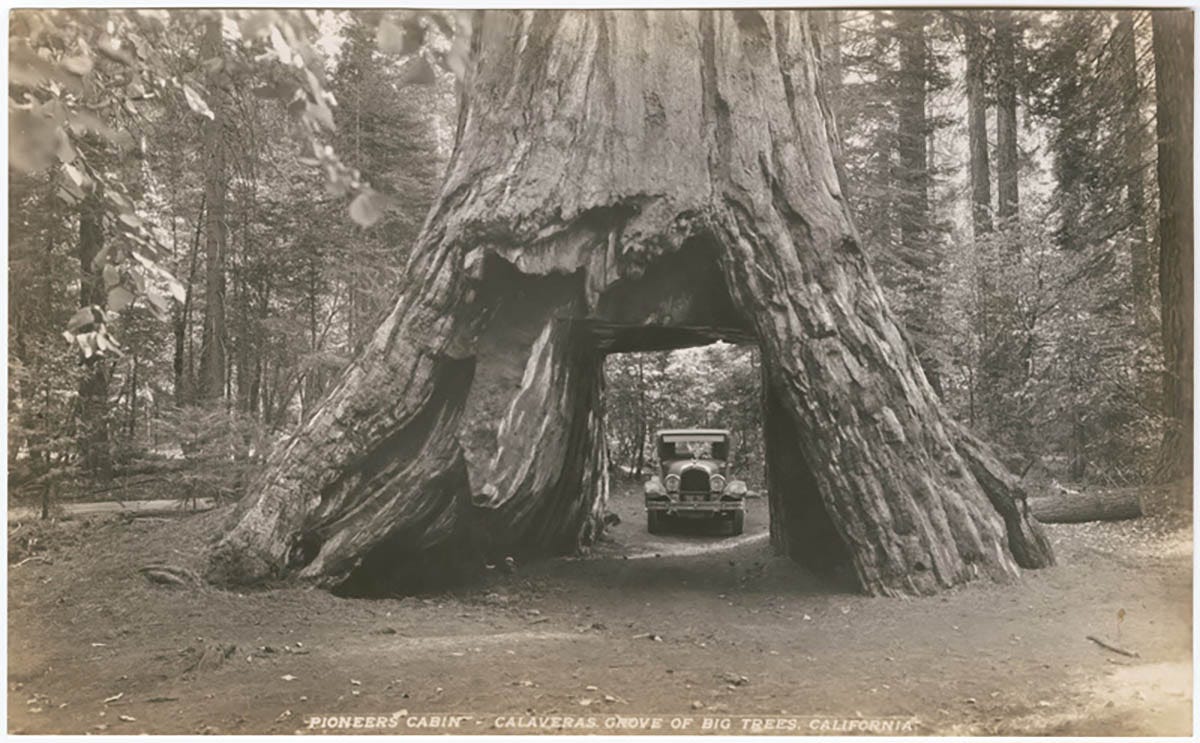Volume 1, Number 20 - Monday, Dec. 19, 2022
The 2022 Trek to the Tree event in Grant Grove (Kings Canyon National Park) had to be canceled this year due to heavy snow and ice, but park rangers observed the long-standing tradition of laying a memorial wreath at the Grant Tree to honor those who have given their lives for their country. — Courtesy of Sequoia & Kings Canyon National Park via Facebook
Perspective
JUST AS CALIFORNIANS depend upon snow in the Sierra Nevada to feed watersheds, giant sequoia trees need a lot of water. So it’s good news that recent storms have covered ground around the groves with a good deal of snow. So much, unfortunately, that the annual Trek to the Tree event sponsored by the Sanger Chamber of Commerce had to be canceled.
Sanger, California, is located about an hour west of Grant Grove, and like many of the communities in the San Joaquin Valley has a special relationship with mountain areas to the east. The Sanger Chamber of Commerce in 1926 began promoting an event to lay a memorial wreath at the base of the General Grant tree at 2:30 p.m. on the second Sunday in December.
The chamber had a full busload of people ready to make the trek this year, along with others who planned to drive in their own vehicles, but the event was canceled due to heavy snow and ice. Still, rangers placed a memorial wreath at the base of the mammoth tree.
You’ll see that the sign in front of the General Grant tree also proclaims it to be “the nation’s Christmas tree,” and the tree is also officially a national shrine to our nation’s war dead.
Here’s what the Sanger Chamber of Commerce website says about the Grant Tree and related annual event:
The General Grant Tree was fittingly named the Nation’s Christmas Tree because of its age and size. It stands in Grant Grove of the Kings Canyon National Park.This monarch in both age and stature has stood for an estimated 2,000-4,000 years and has grown to the height of 267 feet. The General Grant Tree was officially dedicated as the Nation’s Christmas Tree on April 28, 1926, by the United States Department of the Interior.
On October 1, 1949, Sanger, California, was recognized by the Post Office Department as the Nation’s Christmas Tree City. Because of such dedication, and because of the work done and interest shown by the citizens of Sanger, California, the Nation’s Christmas Tree has become known nationally and internationally.
Congress, by Public Law 441, made the General Grant Tree a National Shrine on March 29, 1956. Fleet Admiral Chester W. Nimitz, personal representative of the President of the United States, officially dedicated this tree on Nov. 11, 1956, as a perpetual shrine to our nation’s war dead, during a special ceremony at the base of the tree.
The first Christmas service at the base of the tree was inspired by R.J. Senior-then President of the Sanger Chamber of Commerce and Charles E. Lee, then Secretary of the Sanger Chamber of Commerce, in 1925. In 1924 R.J. Senior was wandering through the Grant Grove area. He approached a huge tree, stopped, and stared in awe at the enormous tree. As he stood looking at nature’s masterpiece, a small girl approached. After a moment of complete silence she said, mostly to herself, “What a lovely Christmas tree that would be.”
She then turned and ran off into the grove. They never learned her name, but they couldn’t forget her words.
The following Christmas, Senior, Lee and some friends trekked over what was then a snow-covered dirt road to the park. They placed some flowers beside the tree and held a short service.
Upon returning home Lee wrote a letter to President Calvin Coolidge. Four months later, on April 28, 1926, the president adopted Lee’s suggestion and officially designated the General Grant Tree as the Nation’s Christmas Tree.
Ever since 1926 these services have been an annual event. The service concludes the Christmas Festival Celebration in which the citizens of Sanger and people from all over the world join in stimulating the spirit of “Peace on Earth, Good Will To All Men.” Each year the crowds gather, they sing, pray, and pay tribute to this wonder of nature.
The members of the National Park Service join in the services by placing a wreath at the base of the tree. During the war years, when travel was restricted due to gas rationing, there were no official services. However, a member of the National Park Service walked to the tree and placed a wreath at its base.
The massive giant is large enough to produce enough lumber to construct 35 five-bedroom homes. The tree stands 267 feet high, its lowest branch is 130 feet above the ground, and the circumference of its trunk is 107 feet.
Merry Christmas!
GS Lands Coalition progress
I provided highlights of the report made by the Giant Sequoia Lands Coalition at its Dec. 14 meeting in a special extra edition published earlier this week. Beginning with this edition, I’ll share more detailed information from the meeting, beginning in the north.
The northernmost giant sequoias grow in the Placer County Big Tree Grove on the American River Ranger District of Tahoe National Forest.
The grove is located about 24 driving miles east of Foresthill, California. It is not only the most northern grove, it is the smallest with just six large live specimens, one live sapling and two downed trees, according to a 2013 report.
And, as I’ve reported here previously, the trees in this grove are genetically distinct from other giant sequoia groves and may be inbred, according to this report. Clearly these study of these trees can be beneficial.
In September, the grove was threatened by the Mosquito Fire. While most news of the fire focused on its threat to homes (78 buildings were destroyed) and its size (76,788 acres), it’s important to note that suppression costs topped $181 million. I mention that because the budget for the Giant Sequoia Lands Coalition’s work in 2022 was about $10.5 million. In other words, the amount allocated to management of the giant sequoia groves statewide, even during the extraordinary effort of 2022, is very small compared to what is spent on fire suppression.
But, back to the report about the Placer Big Trees Grove…
While the Mosquito Fire was raging, the Forest Service reported on Dec. 14, officials at Tahoe National Forest worked with partners from the Giant Sequoia Lands Coalition on a strategy to protect the grove from catastrophic wildfire. Fuels treatments were completed within the small grove that were believed to have been able to protect the trees from high intensity fire had the fire made it all the way to the grove.
It was, in fact, just miles away. And the grove will continue to benefit from the work that was done during the fire. Below is a photo that Tahoe National Forest posted on its Facebook page showing firefighters with some of the trees in the small Placer Big Trees grove.
Did you know you can comment here?
It’s easy to comment on items in this newsletter. Just scroll down and you’ll find a comment box. You’re invited to join the conversation!
Giant sequoias in the news
The Dec. 14 meeting of the Giant Sequoia Lands Coalition provided media with fresh material and fortunately that means a fair amount of news about giant sequoias has been published or recorded — although not quite as much as I expected. I suspect that the relatively remote location and concern about the weather may have kept some media away, but the event was also live-streamed, so it may be that the ever-shrinking pool of news reporters is part of the problem. The San Francisco Chronicle sent a reporter and photographer, but not the Los Angeles Times. Nothing in any of the Bees — Sacramento, Modesto or Fresno. But the Union Democrat in Sonora has a report and the Porterville Recorder published my locally-focused report.
Here’s some reading about the Dec. 14 meeting and report for you:
• Jefferson Public Radio: Coalition of tribes, government agencies unite to restore California's giant sequoia population
• Porterville Recorder: Coalition makes progress to save trees from wildfire
• San Francisco Chronicle: Officials doubling efforts to save giant sequoias from future fires. Here’s how it’s going
• Union Democrat: Coalition announces plans for more prescribed burns in Calaveras Big Trees in 2023
• And here’s the news release from the California Department of Parks and Recreation: Giant Sequoia Lands Coalition gains momentum in fight to protect giant sequoias threatened by unprecedented wildfire risk
On a slightly different topic, this story from the University of Washington’s School of Environmental and Forest Sciences describes ways that some of California’s largest wildfires in recent years have actually been beneficial. A key sentence: “Recent work has shown that they can have a Dr. Jekyll and Mr. Hyde split personality – they can be both very destructive and beneficial at the same time.”
Historic photo of the week
Since I was at Calaveras Big Trees State Park last week, I thought this historic photo was appropriate for this edition. I think this may have been a postcard. Amazing, isn’t it? The photo was taken sometime between 1933 and 1935 by George Frederick Haas. — California State Library via Calisphere
Giant sequoias around the world
It’s certainly not a stretch to figure that giant sequoias may grow well in Washington state and, in fact, there are many fine specimens growing in parks and other public places including on the campus of Western Washington University in Bellingham. A giant sequoia there is featured on the campus tree tour. The tree was planted in 1941 by Dr. Irving Miller, a prominent psychologist and longtime chair of the school’s Department of Education and Psychology. It’s said to be about 26 feet in circumference, and 120 ft. high and a photo of its impressive trunk is on the webpage I linked above. It’s not only the tallest tree on campus, it’s decorated as a Christmas tree every December.
Thanks for reading!






